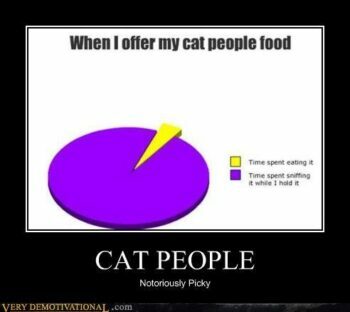Hello, two-legged readers! Lucinda the literate cat here, ready to bring you more valuable cat information. This time we will tell you about human foods poisonous to cats.
This post will be a little different, as my CCL (Cantankerous Cat Lady) is going to collaborate (that’s a new word CCL just taught me.) Anyway, I will write part and she will write the important part.
I will list each poisonous food and give you my reaction to it. Then the CCL will tell you how it poisons the cat. Here’s the list:
1) Alcohol
Lucinda: Fortunately, I’ve never been tempted to taste any of these strange drinks, and actually, I don’t get much chance to try them, as the CCL doesn’t drink much.
I guess it can get you high, something like catnip does, only much stronger, I understand. My catnip reaction is quite enough, thank you! I don’t think it would really be very funny to see a cat acting drunk and stupid.
If you have a lot of alcoholic drinks in your house, please keep them away from your cat, and clean up any that spills. It might take just a taste to make your cat very sick.
Why would a cat even want to try it? It smells terrible. I guess just because the cat sees their two-legged drinking, and is curious about the taste.
CCL: Alcohol is definitely a no-no for cats. Here’s a list of possible symptoms that could result from kitty taking a drink.
- Digestive upset
- Trouble breathing
- Coordination problems
- Central nervous system negative effects
- Coma
- Death
If you think your cat may have sampled your drink, see your vet right away.
2) Chocolate
Lucinda: I know CCL is very fond of chocolate, but has never offered me a taste. Now I know why. If she drops a bit of chocolate on the floor, she’s very quick to pick it up so Pogo and I won’t try it. Now I’m glad I’ve never eaten any.
CCL: According to ASPCA, chocolate contains substances called methylxanthines. These are found in cacao seeds. If your cat eats chocolate, it can cause the following:
- Vomiting and diarrhea
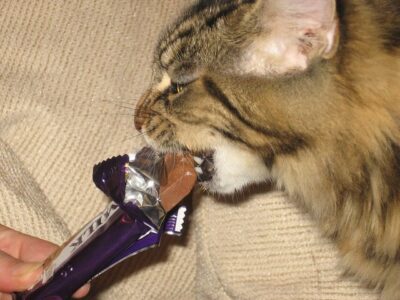
- Panting
- Excessive thirst and urination
- Hyperactivity
- Abnormal heart rhythm
- Tremors and seizures
- Death
White chocolate has the lowest level of methylxanthines, while dark chocolate and baking chocolate have the highest.
3) Coffee, tea, and energy drinks
Lucinda: I know my CCL likes her coffee, though she doesn’t drink much of it these days. She says it keeps her awake. Well, I’ve never had a problem going to sleep, so I guess I’d better not drink any coffee. If she offers me a taste, I think I’ll tell her I don’t want any.
CCL: The offender in coffee is the caffeine. Anything containing caffeine should not be offered to your cat. It could cause the following:
- Hyperactivity
- Increased heart rate
- Tremors
- Breathing difficulties
- Seizures
If your cat took a quick taste, it would probably do no harm, but best not to offer it.
4) Dairy Products
Lucinda: It is said that milk and cheese or such things as ice cream are not good for cats. Sometimes CCL will give me a tiny bit of cheese or a little taste of milk, but never much. I thought she was being mean and just wanted it all for herself. I guess I’ll have to forgive her now.
If I get a chance, though, I’ll steal a little sip of milk or perhaps eat a bit of grated cheese that falls to the floor. After all, CCL has no dog to clean up the food that drops, so I can help out a little bit.
CCL: Cats can be lactose-intolerant, and eating too much dairy of any kind can cause vomiting and diarrhea.
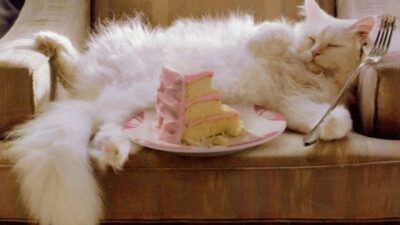
Even though we often think of cats as critters who love to gather around the milk saucer, they just can’t process it in their digestive system. The reason is because they don’t have sufficient amounts of lactose, the enzyme that breaks it down, so it is digestible.
5) Citrus
Lucinda: Why would a cat want to eat citrus fruit? To me, it smells horrible, and I’m not much interested in trying it. However, I guess some curious cats might eat a bit, but they’d better be careful.
CCL: It’s the stems, leaves, peels, fruit and seeds — in other words, the whole ball of wax that is not good for cats because these contain citric acid. It can cause irritation and possible central nervous system problems. As long as the cat only ingests a small dose, it will probably only upset his stomach.
6) Grapes and raisins
Lucinda: My CCL has shown me grapes she is eating, and she lets me sniff them, but I’m not interested. Now I know it is probably a good thing that I didn’t eat any.
I’m pleased thus far — except for the milk and cheese, I am not really interested in the more dangerous human foods, at least so far.
CCL: We know that these fruits can cause kidney failure in dogs, but we are not sure what they will do to a cat. It’s best not to take a chance.
When I lived on Spruce Island, one day I was in my loft reading a book, and munching on raisins from a large bag.
Loose Cat found me and the raisins, and started eating them out of the bag. I let him have what he wanted, not knowing that they could be harmful to him. It was only the one time that he ate them, and fortunately, he showed no ill effect.
7) Raw or undercooked meat; bones
Lucinda: Well, nothing I like better than a little taste of raw meat. After all, in the wild none of our meat is cooked. So, why can’t we eat it?
CCL: In the wild, the meat you hunt for is obviously fresh, unless you are eating road kill. However, raw meat that came from one of our stores may contain disease-causing bacteria, such as salmonella and E. Coli.
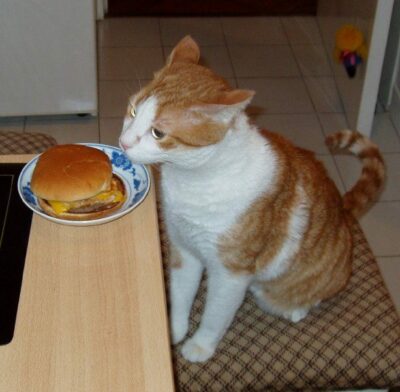
We should be aware that giving our cat bones is not a good idea, as he might choke, or be injured by a bone splinter. Better to leave bones out of the diet.
8) Onions and garlic
Lucinda: The only thing about onions or garlic that might appeal to me are the green tops. They might be tasty to chew on — except now I know it’s best to leave them alone.
It’s too bad I can’t start a school for cats so can teach them what English words mean. It would be helpful if all cats could learn things the way I do. Cats are so independent, though, that they probably would ask for some kind of proof.
CCL: Well, they had best not try the food to see if what you say is true. That could be a disaster!
They would not know that a compound in these plants can cause great digestive upset. This bad compound could damage the red blood cells. If food is cooked with onions or garlic and the cat has a small taste, it would probably be okay. Just be sure the cat never ingests a large quantity of these plants, as it could make him quite sick.
If they were to eat some type of onion regularly, it could cause anemia.
9) Raw Seafood
Lucinda: Well, I’ve heard that it is not good for us to eat shellfish. But raw tuna? Why can’t I eat raw tuna? As far as that goes, why won’t CCL let me eat canned tuna? She will give me a little taste now and then, but never as much as I want.
As far as other raw fish goes, I am not into those appetizers you two-leggeds eat that are made from raw fish.
However, I must agree with Carlos, CCL’s last cat, who loved raw halibut more than anything else, and when CCL had halibut, she always gave him a serving. Apparently it never bothered him.
Now tell me, CCL, why can’t I have canned tuna?
CCL: Well, Lucinda, you can have a bite or two but not a steady diet of it. If you ate just canned tuna, you’d miss out on some of your dietary needs, and if you eat too much of it, you could get mercury poisoning.
Most of the raw seafood one should not give the cat includes raw tuna, anchovies, sardines, herring, carp, mussels and clams. They contain an enzyme that can cause a deficiency of thiamine. Cooking destroys the enzyme.
Perhaps our fresh Alaskan fish is not a problem. I know that Carlos loved his halibut!
10) Raw liver
Lucinda: I have not seen nor tasted liver, though if you put some in front of me, I’d probably try it. I’ve learned that too much of it is not a good thing, as it can cause a vitamin A imbalance. I read that in some book recently.
CCL: Liver is a great source of protein, iron and other nutrients. My mother had a cat who lived for many years — in fact, the cat outlived her. She cooked liver for the cat’s meals. I’m guessing cooking it may make it safer.
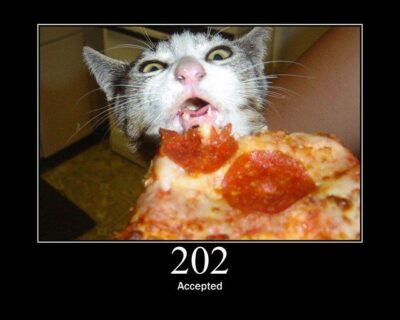
11) Raw dough
Lucinda: I have had a few small bites of raw dough, but I didn’t care for it too much. I guess I’m fortunate that I haven’t ever eaten much of it. So tempting to try anything new!
CCL: It’s the yeast in dough that is dangerous for cats. You are lucky you did not eat much, Lucinda. The yeast can rise, causing painful gas in the digestive system.
Sometimes the stomach can bloat or twist, then causing a life-threatening emergency. Therefore, leave the raw dough alone.
12) Xylitol
Lucinda: So that’s what that stuff is called — CCL puts it in her coffee to sweeten it. I don’t care much for sweets, so have not wanted to try it. That’s a good thing.
CCL: Yes, the xylitol may be okay for me, but in a cat’s body, it can cause insulin release, which can lead to liver failure. Here are other conditions it can cause:
- Increase in insulin production, leading to hypoglycemia
- Vomiting
- Loss of coordination
- Can lead to seizures
13) Dog food
Lucinda: We don’t have a dog, so here’s a temptation I have not had. However, I guess CCL has had a bit of experience with her cat on Spruce Island eating dog food.
CCL: Yes, on Spruce Island my cat, Sam, loved dog food. He’d find the bags and tear them open to munch. He could get into the pantry through a small hole above the door, so nothing was safe unless well-contained.
I finally had to get a big round storage container of heavy cardboard and a tight-fitting lid, and then I could keep the cat out of the dog food.
Cats and dogs have different nutritional needs. Your cat food needs to contain plenty of vitamin A. Also, it is important that the cat gets taurine, which is not included in dog food. Without enough taurine, your cat can develop heart disease or vision and dental issues.
14) Raw eggs
Lucinda: Now, eggs I have eaten a time or two. Fortunately, they were cooked, so I guess it was okay. Upon occasion I’ve had a bit of the yellow part mixed with food, but it has not been harmful. Was I lucky, perhaps?
CCL: Raw eggs can give cats salmonella, and the egg whites have a protein called avidin. When it is eaten raw, it can block the absorption of the B vitamin called biotin from the intestines.
Well, Lucinda, I believe we have covered the major human foods that can be harmful to you cats. I hope this post is helpful.
Lucinda: Yes, this information has been quite helpful to me, because now I know why I can’t eat all the foods that you eat. Do tell me this: You have been offered plenty of gifts from us, such as fat, juicy mice. You always thank me, but do you eat them? I’ve never seen you do so. Perhaps they are toxic to you, even though we enjoy them.
Oh, well, sometimes it’s the thought that counts.
References for this post are as follows:
hillspet.com/cat-care/nutrition-feeding/toxic-foods-for-cats
vets-now.com/2017/02/foods-poisonous-to-cats/

